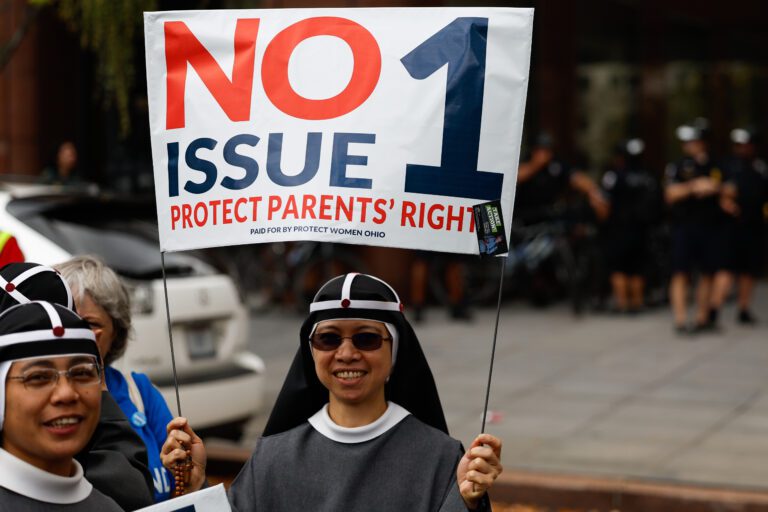
By Marilou Johanek, used with permission from Ohio Capital Journal
It was plain what Ohio voters approved last November with Issue 1. An overwhelming majority of Ohioans voted for a reset on abortion rights after relentless government assault on reproductive freedoms under the state’s patriarchal theocratic rule.
The consensus of 57% of the electorate was to enshrine the fundamental right to abortion in the Ohio Constitution.
Issue 1 also explicitly barred the state from directly or indirectly burdening, prohibiting, penalizing or interfering with access to abortion, and discriminating against abortion patients and providers.
It’s right there in the ballot language of the constitutional amendment voters said “yes” to last November. But now, Ohio Attorney General Dave Yost, who issued a legal analysis that largely stood against Issue 1 before it was approved by voters, argues Ohioans didn’t vote for what they did.
For months Yost has been doing his level best to legally obstruct implementation of the newly amended state constitution by maintaining the legitimacy of burdensome and discriminatory pre-Issue 1 abortion restrictions that clearly violate the letter of the law post-Issue 1.
He slow walks every single constitutional challenge to every single Republican statute still on the books that interferes with abortion access by erecting unnecessary government barriers between a woman and her right to an abortion.
Yost had the gall to contend that Ohio voters didn’t pass Issue 1 to block unnecessary government-mandated delays before patients are allowed to obtain abortions, or to eliminate government-mandated information (that is at least irrelevant and at worst distressing) prior to receiving care.
Yes. They. Did.
Yost cannot pick and choose, a la carte, which provision of the voter-mandated abortion rights amendment applies to unconstitutional restrictions that remain in the Ohio Revised Code.
But that’s what he’s trying to do in courtroom arguments to keep burdensome and discriminatory state abortion restrictions in force indefinitely, including the 24-hour waiting period for abortion patients – a medically unwarranted government mandate not applicable to any other medical procedure – plus separate, in-person visits for patients to be schooled in required anti-choice material designed to discourage abortions.
Yost and his fellow Republican theocrats like to intimate that childlike Ohioans who voted for Issue 1 didn’t fully understand what they were doing. The naïve majority who cast their ballots in favor of the amendment simply failed to grasp what it meant to the common sense abortion regulations Republican men had imposed on Ohio women.
Court filings by Yost’s office suggest gullible citizens thought a vote for Issue 1 would just give women the same abortion rights they had under Roe v. Wade. Never mind what the language added to the Ohio Constitution (and read by Issue 1 voters) actually said.
Yost analyzed that text at length last year before the November election in a disingenuous critique ripped by a former Ohio AG and AG candidate as “a biased hit piece that is intended to confuse voters and weaken support for the amendment.”
Yost concluded that all state abortion laws, such as the 24-hour waiting period and state mandated “informed consent” provisions, would likely be erased if the amendment passed. They “would certainly be challenged under Issue 1” and subject to the “exclusive scrutiny test” of the court as to whether or not they “burden, penalize, prohibit, interfere with, or discriminate against” the right to abortion, reasoned Yost.
The problem is, countered his peers, “no such standard of review exists in law – Yost has created it out of whole cloth to support his arguments.”
Yost was, wrote Marc Dann and Jeff Crossman, “deliberately misleading” with “hyperbolic claims and scare tactics.”
He was also revealing his fealty to partisan extremism over the public interest of truth-telling.
Today, Yost crafts his own textual interpretation of the changes Ohioans mandated in state abortion law and audaciously assumes what voters were thinking when they enshrined the right “to make and carry out one’s own reproductive decisions” in their constitution. It is obvious he does not respect the will of the people or acknowledge their sovereignty in self-governance.
Yost, ever the media hound, wants to attract attention as a courtroom combatant for the hard right. To that end, he will fight constitutionally protected abortion rights in Ohio with protracted litigation and frivolous appeals to subvert implementation of the law with whatever legal tool he has to keep Ohio women subjugated as second-class citizens.
Yost is fixated on generating headlines and getting on TV. So he pursues partisan lawsuits with other Republican AGs to exploit MAGA wedge issues, especially concerning transgender equality, and files a slew of Trump-loving, regulatory-hating amicus briefs to the Supreme Court.
Ohio’s chief law enforcement officer waves off Trump’s 88 felony counts in four jurisdictions for charges ranging from “pervasive and destabilizing lies” about election fraud to illegally hoarding classified documents and falsifying business records in a hush money coverup to win the 2016 election. Yost appears guided by selective application of the law when it comes to the accused felon and presumptive presidential nominee of his party.
But Ohio’s AG is misguided if he thinks Ohioans are willing to concede that same selectivity when it comes to their hard-won constitutional right to reproductive freedom. They know what they voted for and so does Yost.
Bruce Gerencser, 68, lives in rural Northwest Ohio with his wife of 47 years. He and his wife have six grown children and sixteen grandchildren. Bruce pastored Evangelical churches for twenty-five years in Ohio, Texas, and Michigan. Bruce left the ministry in 2005, and in 2008 he left Christianity. Bruce is now a humanist and an atheist.
Your comments are welcome and appreciated. All first-time comments are moderated. Please read the commenting rules before commenting.
You can email Bruce via the Contact Form.



